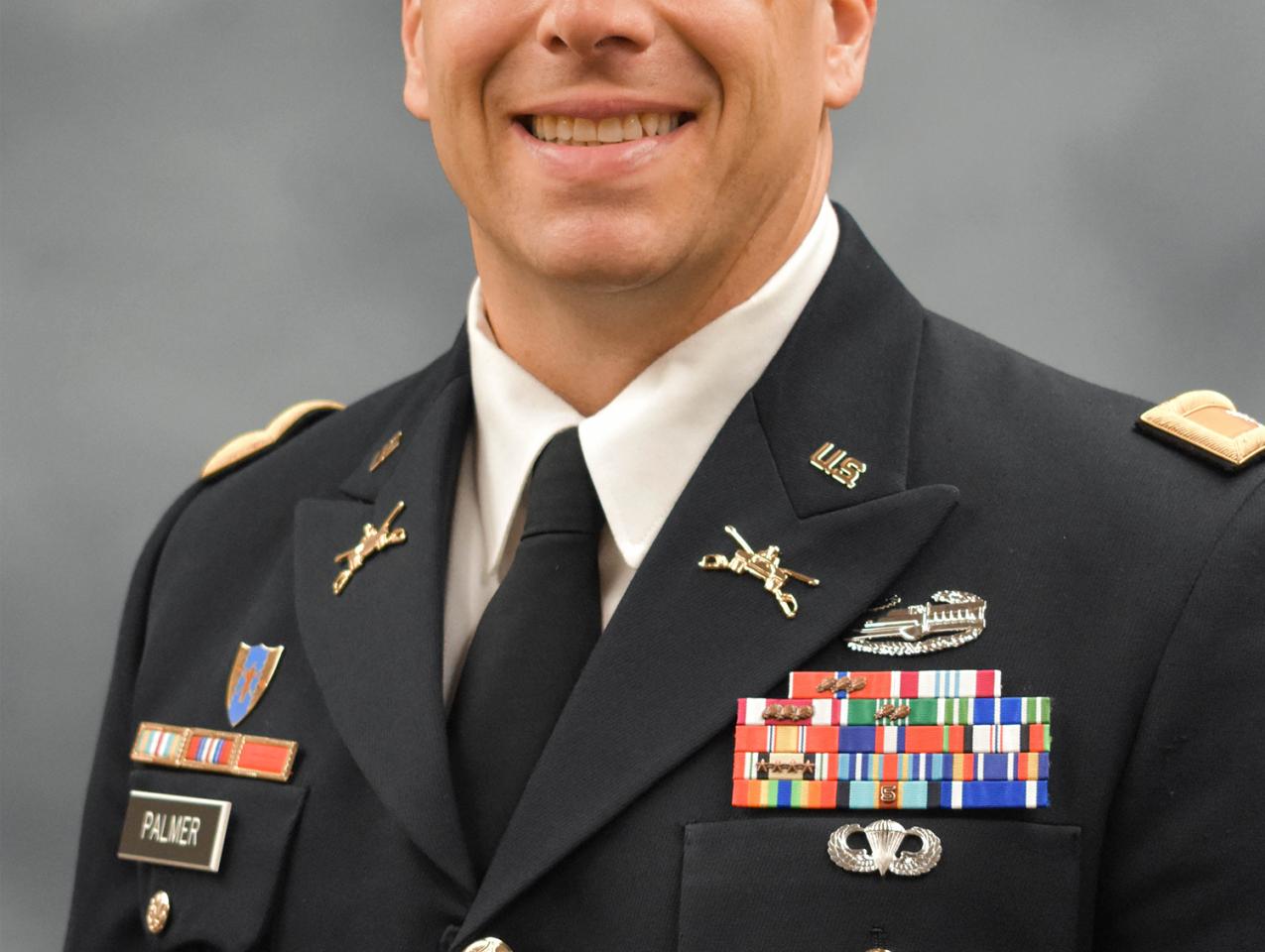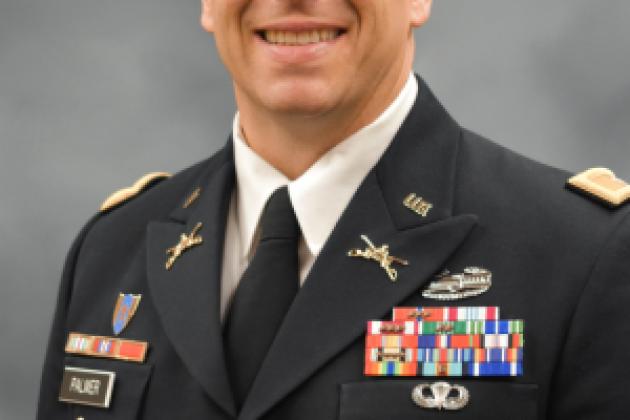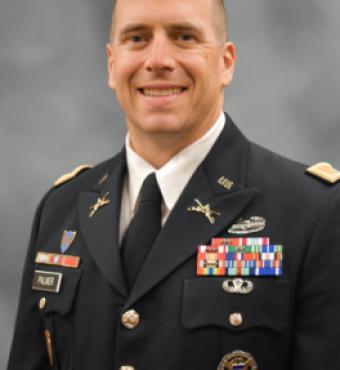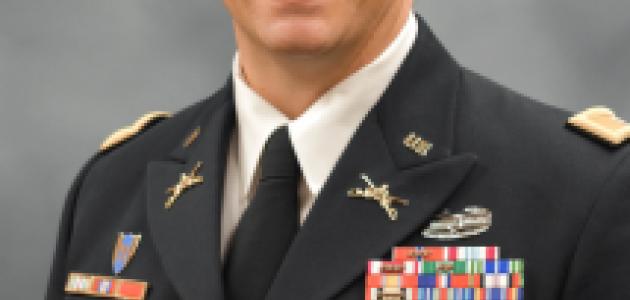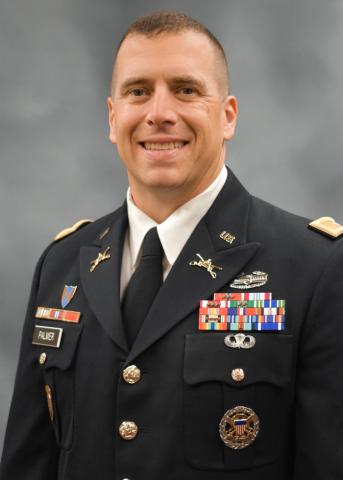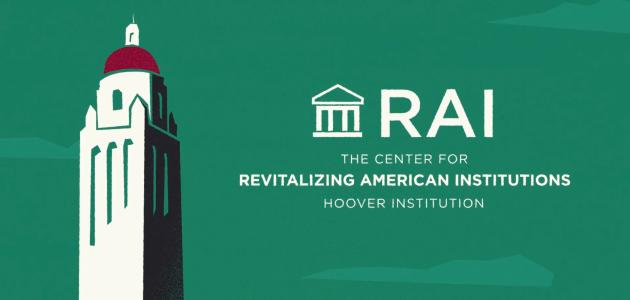by Jonathan Movroydis
Colonel Ian Palmer, representing the US Army, is a National Security Affairs Fellow for the academic year 2019–20 at the Hoover Institution. In this interview, Palmer discusses his combat service in Afghanistan and Iraq; his research on the geostrategic importance of Ukraine; and his work on shaping the US Army to adapt to modern conflict.
Why did you join the US Army?
I spent a lot of time in the woods growing up. I hunted and camped with my father since I was seven or eight years old. I also played a lot of outdoor sports. I think these experiences were a solid foundation for my career in the army.
Between my junior and senior years of high school, I attended a mock government program, which military recruiters attended. I went to the army table first, and the recruiter handed me an application for a ROTC scholarship. I submitted it quickly and shortly thereafter received a four-year reward to attend a school of my choice.
Can you describe your educational background?
I received invitations to apply to several campuses. I was accepted to Carnegie Mellon, in Pittsburgh, which I initially planned to attend. However, my high school mentor encouraged me to also apply to the University of Notre Dame. I didn’t know much about the school other than its championship football program. I was enamored by the South Bend campus’s history and beauty, which I visited only after I was accepted. This visit convinced me to scratch all other options off the list and enroll in Notre Dame the next fall as a psychology major.
Many aspects about Notre Dame resonated with me. Throughout the beginning of the twentieth century, it was just a small Catholic school. By World War II, it almost shut down, because its all-male student population was mostly deployed to battle zones in Europe and the South Pacific. Chance would have it that the US Navy hosted officer training at Notre Dame and helped the university endure those tough times. This partnership explains why the Fighting Irish play the navy Midshipmen every year in football. Today, 10 percent of the student population is involved in ROTC. The history of strong ties between Notre Dame and the US military made me appreciate the experience all the more.
Midway through my career, I pursued a master’s degree in liberal arts at Louisiana State University while stationed in nearby Fort Polk. The curriculum was oriented toward military history and helped me to get a jump start on thinking about strategy, outside of the tactical issues I was dealing with on a daily basis. Later, as a major, I worked toward an MA in national security from the Naval War College. It was a three-semester program in which the focus was naval and joint forces operations, issues involving South America, and military theory.
What have been your most notable assignments as a US Army officer?
From February to April 2003, I deployed to Turkey as part of the First Infantry Division. Our mission was to set up lines of communication and prepare the pass for the Fourth Infantry Division into northern Iraq. The plan was to establish a second northern front in order to split Iraqi divisions to fight in two directions. However, Turkish Parliament voted down US forces’ plans to carry out this strategy. Instead, the Fourth Infantry Division advanced from the south through Kuwait and into Iraq.
From 2004 to 2005, the entire First Infantry Division was deployed to Iraq. This was my first combat deployment. By this time, the insurgency was starting to get some legs. Many of the Iraqi people felt disenfranchised, especially after the US Department of Defense issued the order for de-Ba’athification, and stripped most party supporters from their military and civil service positions.
I was stationed just east of Samarra along the Tigris River, in Saladin Province. This is a heavily concentrated Sunni area, which was influenced by radicalized elements in Fallujah and Al-Anbar. Our mission was to defeat any insurgency and violent opposition to the new Iraqi government. Some of our work included re-establishing and training Iraqi security forces at the grassroots level.
Counterinsurgency operations have many components. Population security is the number-one goal and is informed by relationships with the tribal elders, local government officials, and everyday people.
In 2005 the US military hadn’t entirely figured out how to deal with an insurgency. Intuitively, it seemed to me that we just didn't quite understand and were antagonizing people with an entirely different culture and worldview. Put yourself in the shoes of a villager when he sees an American tank rolling down their main street. When I returned to Iraq in 2009 and 2011, I think we were a lot smarter about how we were executing the war.
Before I arrived at Hoover, I was a commander in the army's first Security Forces Assistance Brigade in Afghanistan, an initiative created by General Mark Milley when he was army chief of staff. His goal was to establish “advising” into the permanent capability of the army. Essentially, army combat brigades were conducting advising in Iraq and Afghanistan (among other places), which distracted them from their core competencies, hurting overall army readiness. Adding advisor units as permanent force structure allows combat units to stay focused on large-scale combat and increases the quality of the advising.
By the end of 2016, the Department of the Army started to support this concept. By spring of 2017, I showed up as one of the first battalion-level commanders of the six battalions in the brigade. In 2018, we deployed to Afghanistan for nine months. My unit was primarily stationed in Logar Province, just south of Kabul, but we spread throughout other parts of the country. My assigned counterpart was an Afghan National Army commanding general. Each of my staff also had an Afghan counterpart. This mission was very valuable. Since 2014, we hadn’t had advisors below the brigade level. It gave the Afghan National Army a much-needed boost in morale.
What books have guided you throughout your career?
Karl von Clausewitz’s On War is required reading for every army officer. In studying conflicts, I like a book or two that lead me to think about broader strategic issues. T. R. Fehrenbach’s This Kind of War: The Classic Korean War History is a book I frequently reference. The Limits of Airpower by Mark Clodfelter discusses how strategy in Vietnam varied year to year throughout the administrations of five presidents. Though it’s a book about airpower, it’s also about overall war strategy.
I love biographies. Colin Powell’s memoir, My American Journey, is one of my favorites. I didn’t love Tommy Frank’s book American Soldier, but it has interesting perspectives on decision making during the wars in Afghanistan and Iraq. President George W. Bush’s Decision Points was also a valuable read along the same lines. I also enjoy reading historical fiction. Killer Angels by Michael Shaara personalizes Confederate generals Robert E. Lee and James Longstreet, as well as Union general John Buford (one of my personal heroes) during the US Civil War.
What are your research goals at the Hoover Institution?
I am breaking up my goals at Hoover into two parts. My first objective of being here is learning as much as I can from the various fellows. I participate in lectures, roundtables, and symposiums as much as possible. I have really enjoyed the series of programs chaired by Secretary Shultz, Governance in an Emerging New World. These discussions cover issues at a strategic level on practically everything, from the Indo-Pacific region to the realms of cyber and outer space.
Secondly, in terms of research, I have always been very intrigued by Russia. I grew up a Cold War baby. As an armor officer I learned about the Fulda Gap in Europe, where US forces were preparing for tank battles against the Soviet Union throughout the 1980s and early 1990s. This knowledge provided a foundation for further research on current affairs regarding Russia and Eastern Europe. I completed a research paper about US policy toward Ukraine as it relates to establishing deterrence against Russia’s expansionary ambitions and threats to NATO partner countries. I am looking at this issue not just from a military perspective but also its economic and social components.
I believe Ukraine needs the right package of foreign aid. I don't mean just money. Ukraine’s demographics skew toward the young, who are inclined to be less reliant on Russia and have favorable views toward a stronger relationship with the West. Their president, Vladimir Zelensky, has shown potential as a leader. If we invest properly in this relationship, it will benefit the long-term strategic interests of both the United States and Ukraine.
Such a strategy could resemble our Plan Colombia of the early 2000s. Our number-one goal was to stop narcotrafficking into the United States. This failed miserably. However, the policy helped make important reforms within the Colombian government, enabled its military forces to defeat FARC (the Revolutionary Armed Forces of Colombia) guerillas, and ultimately resulted in a US-Colombia free-trade agreement.
I believe we need to re-engage Ukraine in a similar way, especially given the damage the relationship suffered as result of the recent impeachment investigations.
Has your experience at Hoover made you think differently?
My experience with Hoover fellows has offered me a perspective that I greatly appreciate, in two specific ways: strategy from nonmilitary perspectives, and with long views of strategy (versus short-term policy). Having the opportunity to hear former secretaries of state and defense, economic advisors, national security advisors, etc., talk about strategic policy has been an experience of a lifetime.
What do you hope to bring back to the service from your experience at Hoover?
After this fellowship, I will lead an armored combat brigade in Texas for the next two years. My time at Hoover has helped me gain greater perspective on the concept of strategic leadership. I believe you can be an operational or tactical leader and also have a larger sense of how your role plays into the organization’s strategy and objectives. This also enables the leader to better communicate mission goals to his or her subordinates. Wherever the army sends me in the future, I hope to be in a position where I am helping to shape policy at a strategic level and making valuable recommendations to senior leaders.
What does leadership mean to you?
If you strip away the tanks and artillery, the army is essentially a people business. Understanding the motivations of people and how they interact with one another is integral to leadership. In an organization as large and diverse as the army, individual troops are inspired by different styles of leadership. A good leader is able to adapt his or her message and call people to action.
Some people are motivated by tough love. Some are not. Let's say I was a squadron commander at Joint Base Lewis-McChord and had six different captains in charge of company-size elements that worked for me. Those captains all had different backgrounds, experiences, and interests. In this instance, I could take a hands-off approach and empower this diversity by giving very basic guidance and a little bit of push.
Other people need more detailed guidance and a stronger push. If subordinates refuse to properly follow orders, a commander may need to become confrontational. In either case, a leader should get to know and understand his or her subordinates. Trust is also vitally important. Secretary Shultz says, “Trust is the coin of the realm.” Trust is essential to cohesion within an organization, especially in dangerous work as the military. Many times, troops in a platoon are spread out from one another. What holds them together and enables them to complete their mission objectives is trust.
Trust isn’t achieved automatically. It is based on building relationships, and through personal investments such as tough training, shared hardships, and team victories. I like using the analogy of a tree. When seeds are planted, a tree isn’t fully grown the next day. The seedling needs to be watered and cared for constantly before it grows high and develops strong roots and branches.
What do you do for fun?
My wife and I have seven children, so they keep us occupied. We spend a lot of time doing things as a family. I enjoy playing all kinds of sports, exercising, reading, watching movies, and listening to music.










